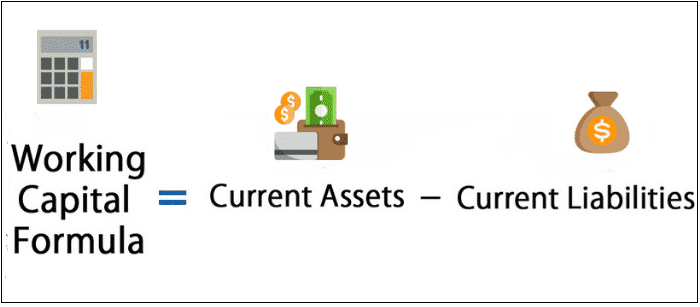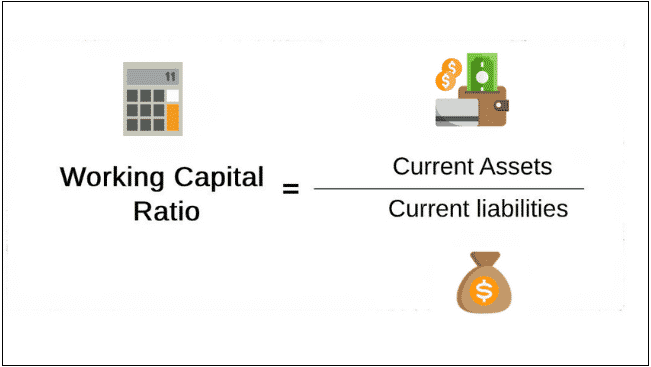How to Calculate Working Capital?
Posted on: April 6, 2022 | Category: Working Capital

Subtracting current liabilities from current assets of a company gives you the company’s working capital. If all other factors are equal, a corporation with more working capital or positive working capital will be less financially stressed.
On the other hand, a corporation that has more than enough working capital on hand isn’t making the best use of it.
What is Working Capital?
Working capital is the money left over after a company has paid off all of its current liabilities using current assets. Debts due within one operational cycle or one year are referred to as current liabilities. Current assets are assets that a business expects to use in the near future.
Income taxes payable, payroll taxes payable, short-term loans, and accounts payable are examples of current liabilities.
Inventories, liquidated investments, accounts receivable, and cash are examples of current assets. Comparable businesses in similar industries do not usually account for current assets and liabilities in the same way internally or on their financial statements.
Similar firms can operate with varying levels of operating capital and still succeed well. It is also possible to do successfully while having negative working capital. As a result, the working capital cycle should be considered in the context of the company’s industry and financial structure. The company should have effective working capital management to embrace sufficient working capital or adequate working capital.
How to Calculate Working Capital?

The working capital formula is:
Working Capital = Current Assets minus Current Liabilities
The working capital calculation lets us know the transient fluid resources accessible after momentary liabilities have been paid off. It is a proportion of an organization’s transient liquidity and is significant for performing financial analysis such as monetary investigation, monetary demonstration, and overseeing income.
Let us take a working capital example:
- Cash: $35,000
- Inventory: $215,000
- Accounts receivable: $175,000
- Total current assets: $425,000
- Short-term debt: $53,000
- Accounts payable: $85,000
- Payroll taxes payable: $13,000
- Accrued expenses: $14,000
- Current portion of notes payable: $43,000
- Total current liabilities: $208,000
The working capital calculation for this company is:
Working capital = Current assets – current liabilities
So, $425,000 – $208,000 = $217,000
How To Calculate The Working Capital Ratio?

The working capital ratio equation shows the proportion of resources for liabilities. For example, it states how frequently an organization can take care of its current liabilities with its current assets.
The ratio of the working capital is calculated as:
Working Capital Ratio = Current Assets divided by Current Liabilities.
Let’s consider, for instance, the working capital ratio would be 300,000/200,000 = a working capital proportion of 1.5.
It’s valuable to know what the ratio is because, on paper, two organizations with totally different current assets and current liabilities could appear to be indistinguishable assuming you depended on their working capital figures alone.
What Is A Good Working Capital Ratio?
A greater ratio indicates that there is more cash on hand, which is typically a positive indicator for a company. A lower ratio indicates a company’s liquidity crisis, therefore a sales slowdown might result in a cash flow problem.
In general, the current ratio of less than 1 might suggest potential liquidity issues, whilst the current ratio of 1.2 to 2 is regarded as desirable. If the current ratio is greater than 2 or excessively high, it may show that the company is holding too much cash with itself rather than investing it again in the company to drive business growth.
Components Of Working Capital:
Current Asset:
This is the value of a company’s current assets (both tangible and intangible) that can readily be converted into cash within one business cycle or one year, whichever comes first. Also, these items are on the company’s balance sheet. Checking and savings bank accounts; highly liquid marketable securities such as exchange-traded funds (ETFs), mutual funds, bonds, and stocks; money market accounts; cash equivalents, accounts receivable, inventories, and other shorter-term debt or prepaid expenses are all examples of current assets.
Current assets from terminated activities and interest payments are two other instances. Remember that current assets are assets that can be turned into cash rapidly and do not include illiquid investments or long-term investments such as hedge funds, real estate, or collectibles.
Current Liability:
A Company’s current liabilities, on the other hand, are all the financial obligations and costs that the firm intends to pay off within a year or one business operating cycle, whichever comes first. Interest payable or principal payments on debt, raw materials, and supplies, utilities, rent, accounts payables, accumulated liabilities, enough liquid assets and accrued income taxes are often included in this category.
This includes dividends due, long-term debt that is about to mature and capital leases due within a year.
Importance Of Using The Working Capital Formula:
The net working capital formula helps you understand your cash flow statement or income statement and ensures that you have enough cash to keep your firm functioning smoothly. This includes your company’s ability to meet your day-to-day operations of finances. It’s also critical for boosting growth and making your company more robust to ups and downs.
You should prepare your firm for any unforeseen costs just as you would your personal finances. Having working cash on hand means you’ll be prepared to deal with any unexpected expenses.
Working capital, on the other hand, allows you to respond rapidly to new possibilities and helps your company weather any storms. Most businesses experience downtime at some point. If you run a seasonal business, this is a natural part of the process. Peak sales and hence increased income during busy times maybe your company’s yearly purple patch, but having enough working capital helps you to stay in business for the rest of the year.
If you need working capital loans for your small business, USBFund can help. For more assistance, get in touch with us.
Limitations of Using Working Capital:

Working capital, while a good instrument for understanding how much financial wiggle room a firm has, it has its limitations. A capital-intensive company like heavy machinery manufacturing is a good example.
These companies specialize on high-priced things that take a long time to build and sell, so they can’t rely on inventories to generate revenue rapidly. They have a large quantity of fixed assets that can’t be sold and pricey equipment that serves a niche industry.
This sort of company’s inventory is often ordered months in advance, and it can seldom be acquired and utilized to produce equipment quickly enough to obtain funds in the event of short-term financial health issues. It’s possible that by the time it’s sold, it’ll be too late. These businesses may struggle to retain adequate working cash on hand to weather any unanticipated crisis.
You should utilize these ratios and formulae, like other financial analysis ratios and formulas, to create a comprehensive view of an investment’s worth. Because the working capital of one firm will differ from that of another comparable company, comparing them may not be the best way to apply the concept.
When Is Negative Capital Okay To Have?
Contingent upon the sort of business, organizations can have negative working capital yet get along admirably. Models are supermarkets like Walmart or inexpensive food chains like McDonald’s that can raise cash quickly because of high stock turnover rates and by getting installments from clients within an issue of a couple of days. These organizations need minimal working capital being kept available, as they can produce more very soon.
Items that are purchased from providers are promptly offered to clients before the organization needs to pay the seller or provider. Conversely, capital-concentrated organizations that fabricate weighty hardware and instruments typically can’t raise cash rapidly or get its money converted into cash, as they sell their items on a drawn-out installment premise. When they can’t sell sufficiently quickly, cash will not be accessible promptly during extreme monetary times, so it is fundamental to have satisfactory working capital.
Do whatever it takes not to perplex transient working capital necessities and very tough requirements. While it might be alluring to use a working capital credit augmentation to purchase equipment or land or to select very tough specialists, these purposes call for different kinds of subsidizing. Expecting you to tie up your working capital credit augmentation on these expenses, it won’t be available for its arranged explanation.
While you can’t expect everything to know about running an association, a sensible point of view on working capital can help you with working impeccably today – and set you up for long stretch improvement with respect to financial modeling tomorrow.







